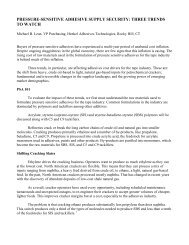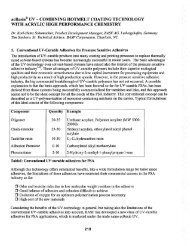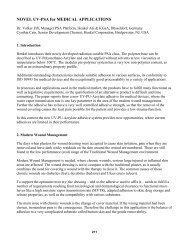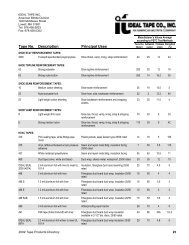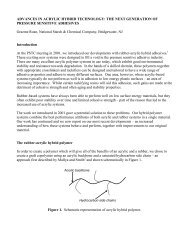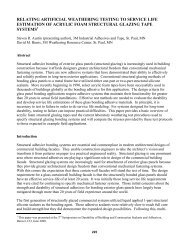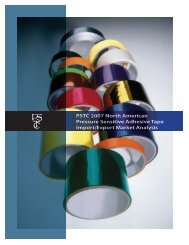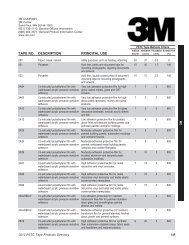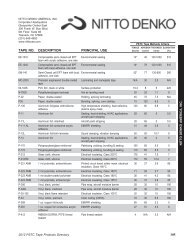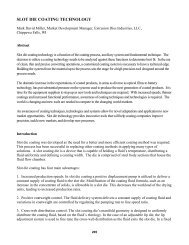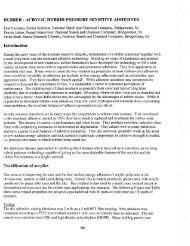Download Paper. (PDF) - PSTC. Pressure Sensitive Tape Council
Download Paper. (PDF) - PSTC. Pressure Sensitive Tape Council
Download Paper. (PDF) - PSTC. Pressure Sensitive Tape Council
You also want an ePaper? Increase the reach of your titles
YUMPU automatically turns print PDFs into web optimized ePapers that Google loves.
However, Williams Plasticity also suffers from several shortcomings, some of which aresimilar to shear and some of which are unique to this test. Like the shear test, WilliamsPlasticity is impacted by significant variability in the results. This variability is stronglydriven by the sample preparation sensitivity of the 2.0 g adhesive ball sample.Experience in plasticity sample preparation improves error, but it remains significant.The test also involves significantly greater labor relative to the shear test due to the effortrequired to produce the spherical sample. In addition, the test provides a bulk creepresistance measurement. Coated PSA film cannot be tested directly using WilliamsPlasticity. As a result, plasticity cannot be used to determine important properties such asthe relationship between coating weight and the risk of problems relating to creep (edgeooze and halo effects worsen with increasing coating weight), as well as samplebehaviors related to sample aging.Texture Analyzers have been utilized in the PSA industry since the development of theAvery Adhesive test. 13 Although developed for the food industry, this instrumentprovides an excellent platform for PSA testing. In addition to the initial ball probe tacktesty, multiple Texture Analyzer tack tests, based on cylindrical probes, have beenutilized to test a large variety of pressure sensitive adhesives). 14-16 In addition, theinstrument has been adapted to perform numerous adhesion tests, including temperatureprofile, 17 90° peel-wheel, 18 and standard 180° tests. 19 Static lap shear 20 , as well asdynamic tensile testing 21 testing of PSA-coated stock has also been carried out using aTexture Analyzer. These are useful techniques for characterizing cohesion, especially thedynamic tensile test, which was shown to correlate highly to static shear. In addition,Texture Analyzers have also been utilized to develop viscoelastic profiles of thick PSAsamples. 22Ashland has developed a compressive creep resistance technique utilizing a textureanalyzer and a cylindrical probe typically utilized for PSA tack testing. The instrumentapplies a static force to the PSA sample, which responds to the force by diffusing awayfrom the probe contact area. The diffusion decreases the measured force and provides avery facile method to determine creep resistance measurements that correlate linearlywith Williams Plasticity.2. Experimental MethodsPSA-coated film preparationStatic shear and Force Retention were performed on 1 mil dry PSA coated on polyester.Except in cases where adhesive was production-coated, the adhesive-coated stock wasproduced via the transfer-coating method. The solution acrylic PSA was coated to 90#Kraft Liner (Loparex ® ) using a Baker Bar. The bar was set to the wet film thicknessappropriate for producing 1 mil dry PSA films. Following draw-down, the films wereair-dried for 15 minutes prior to forced-air oven drying for 10 minutes at 100 °C. Thedry coated PSA films were laminated to 2 mil polyester film after being allowed to coolfrom oven temperature to room temperature.
Williams PlasticitySolution-based acrylic PSAs were drawn down onto release liner using a Baker Bar set toa wet film thickness of 10 mil. Following 15-minute air drying and 12-minute ovendrying, spherical samples were hand-prepared from these films. Once the spheres wererolled to a mass of 2.0 ± 0.1 g, they were placed between two pieces of release liner. Theballs were then placed into the plastometer oven and allowed to equilibrate at 93 °F for aperiod of 20 minutes. After equilibration, the plastometer applied a force of 2 kg onto thespheres for 14 minutes. The sample thicknesses were measured after 14 minutes todetermine the plasticity.Static ShearThe static shear testing was carried out in accordance with <strong>PSTC</strong>-107, Procedure A.Stainless steel panels were cleaned using acetone and stored under constant temperatureand humidity conditions for 24 hours prior to use. The coated stock (1 mil dry PSA on 2mil polyester film) was bonded to the panels with a 1” X ½” contact area and allowed tobond for 15 minutes. After conditioning, the panels were hung vertically and a 1 kgweight was attached to the film. The shear failure times were recorded in hours.Figure 1. Apparatus utilized for Force Retention testing of acrylic PSAs.
10090y = 10.2x + 29.5R 2 = 0.9680Percent Force Retention7060504030201001.0 1.5 2.0 2.5 3.0 3.5 4.0 4.5 5.0 5.5Williams PlasticityFigure 4. Direct comparison between average Force Retention and Williams Plasticitymeasurements of eight unique PSAs indicates excellent linear correlation.PSA Performance OptimizationThe overall PSA performance of acrylic solvent-based pressure sensitive adhesives canbe modified by changing the crosslinker concentration. The goal of most solvent PSAcrosslinker optimizations is to maximize adhesion and tack while maintaining sufficientcohesive strength to ensure robust product converting ability and cohesive performancein the application. The traditional approach has been to create a crosslinking “ladder”which, plots PSA performance values, including shear failure times, versus crosslinkerconcentrations. In most cases, shear failure times start very low (less than 1 hour) andrapidly increase with increasing crosslinker concentration (Figure 5). Shear failure timesbecome highly sensitive to crosslinker concentration at increasingly high levels.One challenge of the shear test sensitivity to higher crosslinking is that it can bechallenging to determine the crosslinker concentration that provides sufficient cohesionover typical lot-to-lot variation of adhesive. In contrast, Force Retention measurementsfor the same pressure sensitive adhesive samples over this crosslinking range gave rapidinitial rise of creep resistance, followed by a significant flattening of the crosslinkingcurve. The advantage of this data set is that it clearly identifies 85% relative crosslinkercontent as the point at which creep resistance does not rise very rapidly with additionalcrosslinker. As a result, it was determined that 90% relative crosslinker was theminimum acceptable crosslinker loading needed to ensure product cohesion capability.
50Mean Shear Failure Time (h)40302010132344015527085100Relative Crosslinker Percent115Figure 5. Solvent PSA shear failure time increases drastically with increasingcrosslinker amounts.75Percent Force Retention706560555049626670454041557085100Relative Crosslinker Percent115Figure 6. Force Retention data for increasing crosslinker indicates inflection point at85%, beyond which limited cohesive strength is gained with increasing crosslinker.
Utilization of Force Retention in Process Control DeterminationShear is commonly utilized as the PSA cohesion quality control tool in acrylic PSAmanufacturing. However, the test limitations discussed in the introduction result canresult in process data that may not adequately reflect the capability of the productionprocess. In addition, large test variation can increase the likelihood that an atypicalproduction batch of adhesive is detected incorrectly, either as a false positive orundetected negative result. Finally, many shear tests on PSA-coated films can takemultiple days, reducing the speed at which lots can be released for shipment tocustomers.The control chart in Figure 7 was generated from 15 lots of typical solvent acrylic PSAthat was coated on production equipment. Utilization of machine-coated stockminimized testing variation due to sample preparation, enabling an improved focus on thecapabilities of the process and test. The shear data generated from these fifteen lotsranged from 30 to 71 hours. The data series was deemed to be typical of othercomparable solvent acrylic PSA products for both the sample mean and sample rangevariation. However, both the sample means and ranges were very significant in relationto the process mean. The process control limits were calculated to be ± 42% of thesample mean. In addition, there were three lots with shear values that deviatedsignificantly from the mean (samples 4, 8, and 9). Based on shear testing alone, it wouldappear that the process capability was limited. However, without an additional capablecohesion test, it would have been difficult to achieve an accurate determination of processcapability.The fifteen production-coated lots of solvent PSA were also tested using Force Retentionand the results were compared to the shear testing. Significant reductions in both thesample mean and range control limits were observed (Figure 8). The potential outlyinglots #4, 8, and 9 identified by the shear testing were determined to be typical lots. Incontrast to the shear control limits being ±42% of the mean for the shear testing, the forceretention process control limits were determined to by ±6% of the process mean (and theaverage sample ranges of the shear tests were three times greater). Process capabilitywas determined to be significantly better using the Force Retention method, due to theimproved reproducibility. In addition, using Force Retention as the primary QC tool forthis process instead of relying on shear would reduce the average sample testing timefrom two days to 30 minutes.
Mean Sample Shear Failure MeanTime (h)7060504030UC L=72.13_X=50.65LC L=29.1712345678Sample9101112131415Sample Sample RangeRange60453015UC L=54.05_R=21.00012345678SampleFigure 7. Shear failure times of production-coated PSA lots indicates a wideperformance range, despite the fact that the process was known to be under control.9101112131415LC L=0Mean Percent Sample Force MeanRetention7060504030_ UC L=69.31X=65.27LC L=61.2312345678Sample910111213141560Sample Sample RangeRange453015012345678SampleFigure 8. Quality control data of production coated PSA, determined by Force Retentionmethod, and graphed using same axes as the corresponding shear data set.9101112131415UC L=14.82_R=7.01LC L=0
4. ConclusionsA new method, Force Retention, was developed for rapid and accurate quantification ofPSA compressive force creep resistance in coated PSA films. Force retention utilizespre-existing Texture Analyzer probe tack testing equipment already utilized around thePSA industry. Creep resistance is measured reproducibly by measuring the forcedecrease caused by PSA diffusion away from the area of the sample that is under probecontact. This technique was designed to mimic the forces applied in the WilliamsPlasticity test, and correlation testing indicates this goal was achieved. Force Retentionwas also shown to improve both PSA performance optimization as a result of crosslinkeradjustment, and the test method showed that a production process was more capable thanwas apparent based on static shear testing.Force Retention testing enjoys multiple advantages over legacy cohesive tests, includingshorter test time, greatly simplified sample preparation, and improved data quality. Inaddition, the same test configuration can be applied to all PSA types, ranging from noncrosslinkedlow molecular weight thermoplastic to highly crosslinked removablethermoset PSAs. This test technique is still under development and further improvementsin test capability and applicability are expected.5. Future WorkOngoing work is underway to adapt the Force Retention test to the newest-generationStable Micro Systems Texture Analyzer, the TA.XTplus. Differences in software andhardware design and capability will require shifting some of the test settings in order toachieve the same initial target force range and reproduce other key test parameters.Additional data analysis will be applied to the pre-existing database of force retentionmeasurements in order to determine if more accurate creep resistance results can beextracted from this type of testing.Test capability is a critical aspect to improved understanding of this new test technique.Once test conversion to the new texture analyzer is complete, a more thoroughmeasurement systems analysis will be undertaken to determine the impact of all sourcesof sample variation: sample preparation, operator, probe reproducibility, and instrumentvariation.
6. References1. Benedek, I. (1998), Development and Manufacture of <strong>Pressure</strong>-<strong>Sensitive</strong> ProductsMarcel Dekker Inc., New York, pp. 259-262.2. Zosel, A. (1992), “Shear Strength of <strong>Pressure</strong> <strong>Sensitive</strong> Adhesives and Its Correlationto Mechanical Properties” Tech. Seminar Proc., <strong>PSTC</strong> First World Congress, pp. 191-205.3. Test Methods for <strong>Pressure</strong> <strong>Sensitive</strong> Adhesive <strong>Tape</strong>s, 13th edition (2000), <strong>Pressure</strong><strong>Sensitive</strong> <strong>Tape</strong> <strong>Council</strong>, Northbrook, IL, pp. 37-44.4. Antonov, S. V. and Kulichikhin, V. G. (2009), “Shear Resistance” in Fundamentals of<strong>Pressure</strong> Sensitivity, Benedek, I. and Feldstein, M. M. eds. CRC Press, Boca Raton, FL,page 8-1.5. Johnston, J. (1997), “Notes and Observations on the Simple Testing of <strong>Pressure</strong><strong>Sensitive</strong> Adhesive <strong>Tape</strong>s” <strong>PSTC</strong> Tech Seminar Proc., pp. 79-101.6. Satas, D. (1999), “Dynamic Mechanical Analysis and Adhesive Performance” inHandbook of <strong>Pressure</strong> <strong>Sensitive</strong> Adhesive Technology” 3 rd edition, Satas, D., ed., Satas &Assoc., Warwick, RI, pp. 171-203.7. Yao, L and Braiewa, R. (2006), “Consistency of Rheological Experiments for PSACharacterization” <strong>PSTC</strong> Tech Seminar Proc.8. Chang, E. P. J. (1991) “Viscoelastic Windows of <strong>Pressure</strong> <strong>Sensitive</strong> Adhesives”, J.Adhesion, 34, pp. 189-200.9. Griswold, R. M., Eckberg, R., and Frye, R. (2006) “A New Family of <strong>Pressure</strong><strong>Sensitive</strong> Adhesives” <strong>PSTC</strong> Tech Seminar Proc.10. Williams, I. (1924), “The Plasticity of Rubber and Its Measurements” Ind. and Eng.Chem, 16 (4), pp. 362-364.11. “ASTM D 926: Standard Test Method for Rubber Property-Plasticity and Recovery(Parallel Plate Method)” in Ann. Book of ASTM Standards 2005, Vol. 09.01, ASTMInternational, West Conshohocken, PA, pp. 180-183.12. Benedek, I. (2009), “Test of <strong>Pressure</strong>-<strong>Sensitive</strong> Adhesives and Products” inApplications of <strong>Pressure</strong> <strong>Sensitive</strong> Products, Benedek, I. and Feldstein, M. M., eds. CRCPress, Boca Raton, FL, pp. 8-59 to 8-60.13. Chuang, H. K., Chiu, C., and Paniagua, R. (1997), “Avery Adhesive Test YieldsMore Performance Data Than Traditional Probe”. Adhesives Age, September, pp. 18-23.
14. Kim, B. J., Kim, S. E., Do, H. S., Kim, S. and Kim, H. J. (2007), “Probe tack oftackified acrylic emulsion PSAs”. Int. J. of Adhesion and Adhesives, 27 (2), pp. 102-107.15. Trenor, S. R., Suggs, A. E., and Love, B. J. (2002), “Influence of penetrationenhancers on the thermomechanical properties and peel strength of a poly(isobutylene)pressure sensitive adhesive” J. Mat. Sci. Lett., 21, pp. 1321-1323.16. Mitchell, T. (2003) “Advancements in Solventless Technology for Silicone PSAs”<strong>PSTC</strong> Tech Seminar Proc.17. McGuiggan, P. M., Chiche, A., Filliben, J. J., and Yarusso, D. J. (2008) “Peel of anadhesive tape from a temperature-gradient surface”. Int. J. of Adhesion and Adhesives,28, pp. 185-191.18. Trenor, S. R., Long, T. E., Love, B. J. (2005) “Development of a Light-DeactivatablePSA Via Photodimerization”, J. Adhesion, 81, pp. 213–229.19. Kim, J. K, Kim, W. H., and Lee, D. H. (2002), “Adhesion properties of UVcrosslinked polystyrene-block-polybutadiene-block-polystyrene copolymer and tackifiermixture” Polymer, 43, pp. 5005-5010.20. Poh, B. T. and Kwo, H. K. (2007) “Peel and Shear Strength of <strong>Pressure</strong>-<strong>Sensitive</strong>Adhesives Prepared From Epoxidized Natural Rubber” J. Appl. Poly. Sci., 105, pp. 680–684.21. St. Couer, Rich, and Feys, Jennifer (2001), “The Dynamic Tensile Test,” <strong>PSTC</strong> TechSeminar Proc., pp. 5-13.22. Hongsriphan, N., Barry, C. M. F., and Mean, J. L. (2003), “A Test Method toEvaluate the Viscoelastic Properties of <strong>Pressure</strong> <strong>Sensitive</strong> Adhesives Using a TextureAnalyzer” <strong>PSTC</strong> Tech Seminar Proc.





